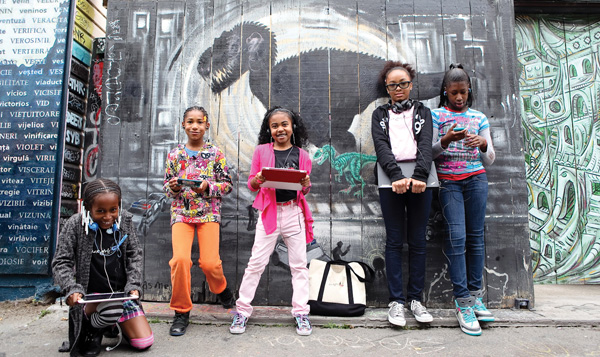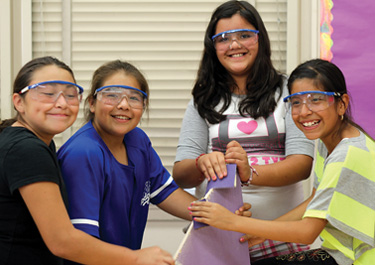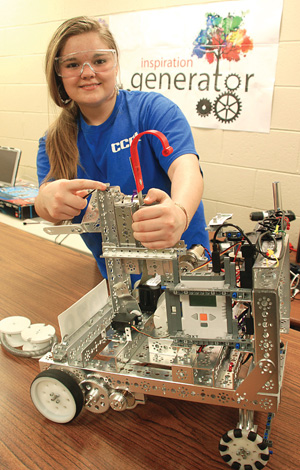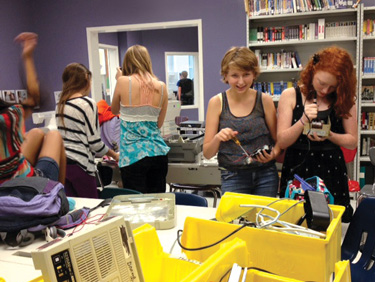![]()

Participants in Black Girls Code are among the growing number of
students bolstered by tech initiatives designed primarily for girls.
Diane Christina Photography (courtesy of Black Girls Code)
Three years ago, Kimberly Bryant, then an engineering manager with an electrical engineering background, decided to create the organization Black Girls Code so that kids like her own daughter, Kai, 15, “could see girls as creators, not just consumers.” It worked. Since 2011, Black Girls Code and its 1,300 volunteers have taught computing skills to 2,500 students, about 75 percent of them African American girls. While all kids are welcome to join, the group reaches out specifically to young women from black, Latina, and Native American communities, since they are the most underrepresented in the industry, Bryant says. “We do try to put a hard line in the sand. We really want the focus on girls.”
Bryant initially recruited volunteers through networking groups such as Women Who Code, and then Google came on board with funds and mentors. Today, Black Girls Code boasts chapters in the Bay Area, Atlanta, Las Vegas, New York, Chicago, Detroit, Memphis, and Johannesburg, South Africa. Bryant, who likes to partner with libraries, schools, and universities, expects to form eight more chapters this year. During Black Girls Code classes, about 50 girls, with help from 25 mentors, may build a website or an app, while also drawing inspiration from teaching volunteers.
Bryant is among the growing ranks of women propelling girls’ exploration of technology, in large part in response to the documented gender gap in tech fields. “Brogrammer culture”—overt or subtle sexism—has also been a hindrance. There are a few high-profile female leaders, such as computer scientist Marissa Mayer, who runs Yahoo, and mathematician and computer scientist Maria Klawe, the president of Harvey Mudd College, but women hold only 24 percent of science, technology, engineering, and math jobs and represent just one in seven engineers, according to “Women in STEM: A Gender Gap to Innovation,” an August 2011 report by the U.S. Department of Commerce.
“If we’re going to out-innovate and out-educate the rest of the world, we’ve got to open doors for everyone,” First Lady Michelle Obama said after the study came out.
What accounts for the gap? The report cites possible reasons such as a lack of female role models and gender stereotyping. Less “family-friendly flexibility in the STEM fields” is also a factor, the study says. Former GitHub employee Julie Ann Horvath is one of several women who have come forward with stories of sexist cultures and harassment at tech companies.
Alternately, “A lot of it comes down to society and this view that scientists are nerds,” says Amy McGovern, associate professor of computer science at the University of Oklahoma and one of the more than 100 computer science graduates interviewed for Jane Margolis and Allan Fisher’s book Unlocking the Clubhouse: Women in Computing (MIT, 2002). “Society tells girls, ‘You shouldn’t be smart and good at math,’” says McGovern. She adds that educators need to “pump up the confidence of the girls who are hearing that.”
Many teachers and librarians are doing just that, applying for grants to buy computers, software, and 3-D printers for programs targeting female students.

Young women from the group DIY Girls sand a piece a wood they
will use in an interactive game they designed. DIY Girls runs programs for Latina girls at L.A.’s Telfair Elementary School, pictured, and Vaughn Next Century Learning Center.
Photo by Youth Speak Media Solutions (courtesy of DIY Girls)
Libraries as labs; librarians as tech role models
The library can be a perfect launch pad for these initiatives, says Gail Dickinson, associate dean for graduate students and research at Old Dominion University and president of the American Association of School Librarians (AASL). “In many respects, being a librarian is an IT career,” she says. “The library is truly a playground where students can experiment with resources, try out their creativity, and explore.”
The school media center at the Douglas Byrd High School in Fayetteville, NC, is such a place.
Every Saturday and Wednesday, ninth-grader Brianna Ellis is at the library using computer programs, a 3-D scanner, and a 3-D printer. One of her goals: to build better rovers for Mars.
Ellis belongs to her school’s 3D-GREES (for “Girls Really Enjoy Engineering and Science”) club, and she would like to go to a NASA summer camp. “Girls don’t understand that they have the potential to do the things guys can do,” she says.
At 3D-GREES, they gain confidence. “A young lady who may consider being a vet might not only be able to build a 3-D model of an injured animal’s heart on the computer to visualize it in 3-D, but also print it out on our 3-D computer,” says assistant principal Yolanda Epps, who started 3D-GREES last September. Alternately, the students might invent video games using Unity, the game development tool. The 3D-GREES program, says junior ShyAnne Clark, “opens your eyes to the endless possibilities you have in technology.”
Epps launched 3D-GREES with the help of a $2,000 grant she received from the Lumbee River Electric Membership Corp., a local electric power cooperative where she also purchased her 3-D scanner and handheld scanner. She also received $20,000 worth of 3-ds Max software, used in video games and movies, from the deputy director of a group called Base Realignment and Closure–Fort Bragg.
Kim Wilkens, a computer scientist and the founder of Tech-Girls (“empowering girls to imagine and achieve their future dreams in our tech-savvy world,” she says), based in Charlottesville, VA, notes, “by age 13, girls determine a positive or a negative attitude toward subjects.” Wilkens runs workshops on designing video games, making websites, and learning electronics.
At the Portland, OR-based App Camp for Girls, seventh-and eighth-grade girls learn how to create their own iPhone Apps during a week in the summer. Founder Jean MacDonald came up with the camp idea during a developers’ conference in 2011. She recently left her job at Smile Software to devote herself to App Camp for Girls full time. “It really impressed me how extreme the gender imbalance was” at that conference, she says. “I thought we could at least get more girls interested in software development.”
And in Crozet, VA, Isabella Kim, 10, and her sister Maya Kim, eight, attend a free hour-and-a-half Tech Girls program offered every two weeks at the Henley Middle School, where they make robots with the Hummingbird Robotics set, along with musical instruments using the MaKey MaKey invention kit. “I don’t know how to code,” says their mother, Stella Kim. “I want them to have that exposure.”
Luz Rivas, founder and executive director of the Los Angeles after-school program DIY Girls, works with low-income Latino girls at Telfair Elementary and the Vaughn Next Century Learning Center school in Los Angeles. The girls use Scratch, a free programming language from MIT for creating stories, games, and animation, to develop video games.
Rivas’s DIY Girls participants start out making light-up greeting cards with tiny LEDs, batteries, and construction paper. “That project costs about 25 cents,” says Rivas. In addition, they create inexpensive vibrating bug toys by soldering wires to a small motor connected to a battery. Her students take on more elaborate projects as well, using a 3-D printer donated to DIY girls by the Rock Hill, SC-based company 3D Systems.

A member of the Library Bots team at the
Chesterfield County (VA) Public Library, where Tech-Girls will host three sessions this month.
Photo courtesy of Chesterfield County Public Library
“Girly” projects and gendered learning styles
While some believe that tech programs for girls shouldn’t be girly, others play to young women’s feminine sides in order to get them in the door, on the theory that girls might learn to use software if the initial purpose is to design nail art or jewelry. At the Chesterfield (VA) County Public Library (CCPL), girls will stitch LED lights into fabric cuffs during a Tech-Girls project this month, says library specialist Blanche DePonte.
Similarly, at the YOUmedia teen tech spaces at the Chicago Public Library (CPL), Marshall Caal, a woman, runs nail art and geek craft activities. While nearly 7,000 teens are registered visitors to CPL’s YOUmedia labs, funded by the MacArthur Foundation, only 20 to 30 percent of workshop participants are female.
“When we focus on the product or the project as opposed to the skills, it’s a bigger draw,” says Adrienne Strock, manager of YOUmedia at CPL. The YOUmedia girls use Adobe Illustrator to design their nail art, as well as other items like T-shirts, says Kiley Larson, a research scientist at the Institute of Human Development and Social Change at New York University (NYU), who studies the program. Even knitting or crocheting are relevant to tech, Larson says, because girls download patterns online. YOUmedia recently launched a Girls Who Code club, with computer scientists and engineers volunteering to teach.
The gender-specific approach isn’t for everyone. “I’m not a big fan of the ‘girl, girl’ things all the time,” says McGovern. She advocates showing young women pictures of eye-opening projects with real-world consequences, such as demonstrating how a 3-D printout of a trachea split could make it possible for a baby to breathe. “Then young girls could use an app like 123D Design to create something much simpler,” she says. “They see it can be used for something cool, and then they do something within their capabilities.”
Learning styles also play a role in girls’ take on tech. While “boys seem to be more comfortable with public failure or challenges,” says Strock, “girls tend to be more comfortable with corrections one-on-one.” She adds, “Girls internalize frustrations and make them so personal.”
Girls also like collaborative learning, says Nanci Clary, the library services administrator at CCPL. “What’s kind of fun about our collaborative learning space is everything is not all this tidy, neat, organized, typically librarian-ish place,” she says. “It’s cluttered, it’s busy, it’s got stuff.” There’s an old typewriter that kids can take apart and repurpose, as well as other outmoded electronics components. CCPL also fields a robotics initiative, with programs from littleBits, which coaches girls to participate in projects from making unintimidating circuit boards, to events focused on Lego Mindstorms robotics sets for older students.
Tech projects don’t have to be complicated to be inspiring. “Get their interest, introduce the science, and build from there,” advises Angela Critics, a young adult librarian at the Jefferson-Madison Regional Library in Charlottesville, VA. To draw in young patrons, Critics hosts activities such as making three-foot-tall roller coasters out of paper and running marbles on them. Other times, she sets out duct tape so young patrons can make everything from wallets to roses that decorate the end of a pencil. “I try to keep it really gender neutral,” Critics adds.

Girls take apart a broken overhead projector in the makerspace
at the Monticello High School in Charlottesville, VA.
Photo courtesy of Monticello High School library.
Finding role models, forging collaborations
“Young women have to picture themselves as computer-science experts,” says Penny Sebring, principal investigator of the report “Teens, Digital Media, and the Chicago Public Library” and co-founder of the University of Chicago Consortium on Chicago School Research. Like Harvey Mudd’s Klawe, she emphasizes the importance of students meeting female computer scientists.
Women at local universities and corporations often donate their time. “Having role models who look like you, who understand you, whether you’re a woman, or maybe you’re black or Hispanic, whom you can look up to, has been really beneficial,” says NYU’s Larson.
“If I were a school librarian, I would try to get some female developers or software designers to talk about the ideas and concepts and how the field is changing and how they need women,” says Mira Zimmerman, 14, a freshman at Forest Grove (OR) High School who interned last summer at App Camp for Girls. “Everyone needs to know how to work on computers,” she says. “That’s sort of the future of all our jobs.”
The ideal is to get women in technology to visit and do a hands-on program rather than just lecture, says Kate Colson, outreach chair of Women in Technology Tennessee, an organization that gives away college scholarship money and funds camps and conferences that help middle and high school students engage in tech. “Girls really respond well to seeing it in action.”
Librarians also can reach out to programs run through groups such as the YWCA, the Girl Scouts, Women@NASA, and the 4-H Science Initiative (a partnership between 4-H and the nonprofit Los Altos, CA–based Noyce Foundation). Other initiatives include the Cambridge, MA–based Science Club for Girls, the Manchester, NY–based For Inspiration and Recognition of Science and Technology (FIRST), and the Lynnwood, WA–based National Girls Collaborative Project.
In Tennessee, TWISTER (Tennessee Women in Science, Technology, Engineering and Research), run by Nashville’s Adventure Science Center, invites girls to a once-a-year program with women in STEM professions. Last year, a highlighted speaker was a woman who had lost her foot, accompanied by a representative from a company that makes prosthetic limbs. “One thing we know from our colleagues at the Carnegie Science Center is girls really want to make a difference in the world,” says Jeri Hasselbring, education director for the Adventure Science Center in Nashville.
Melissa Techman, a librarian at Broadus Wood Elementary School in Earlysville, VA, regularly gets girls to create ebooks with the Web tool Bookr. This summer, they will master Mozilla’s free online tool Thimble to create simple posters and postcards. “Get girls feeling competent, especially with computers and technology, before they hit high school,” says Techman. “If we can help them to play around with stuff at an early age, it’s going to give them more confidence.” Eileen Krepkovich, a biomedical research engineer who volunteers with Tech-Girls on projects such as headbands with light-up LEDs, recently received a National Institutes of Health grant to bring neuroscience concepts into middle-school classrooms.
STEM role models
Kim Wilkens, founder of Tech-Girls, suggests the following sites, games, and books highlighting female STEM-related role models and characters.
The 2013-2014 Young Adult Library Services Association (YALSA) president, Shannon Peterson, also youth services manager at the Kitsap Regional Library in Port Orchard, WA, notes innovative mentor-led programs in libraries, such as the Institute of Museum and Library Sciences (IMLS) and MacArthur Foundation–funded Learning Labs (sponsored by IMLS and MacArthur and inspired by YOUmedia). “It’s so interesting when you go out in your community and realize there are 100 different organizations doing amazing things,” says Peterson. “You’ve got to get out of your building!”
YALSA, working with Best Buy, released 20 mini-grants to libraries for their “DIY @ your library”–themed Teen Tech Week this year. “Think about local partnerships,” says Peterson. For example, the Berwyn Public Library in Cicero, IL, simply collaborated with the local Morton West High School library to host a presentation on how to “create your autobiography book cover” with Microsoft Office. The school anime club met in the library to master Comic Life 3 software.
“Librarians are often our biggest advocates,” says Reshma Saujani, founder and CEO of Girls Who Code, which offers computer-science education through its summer immersion program and its clubs at schools, libraries, and community centers. “It’s really about asking, ‘Who are their role models? Whom do they trust?’ Those people are our librarians.”
Coding “will be like reading,” adds Saujani. “It’s a 21st-century skill for every young girl, whether she wants to be a veterinarian, a dancer, or the next president.”

 Karen Springen spent 24 years as a Newsweek correspondent and now teaches journalism at Northwestern University. An expanded version of this article, with resources from Tech-Girls founder Kim Wilkens, appears on slj.com.
Karen Springen spent 24 years as a Newsweek correspondent and now teaches journalism at Northwestern University. An expanded version of this article, with resources from Tech-Girls founder Kim Wilkens, appears on slj.com.
